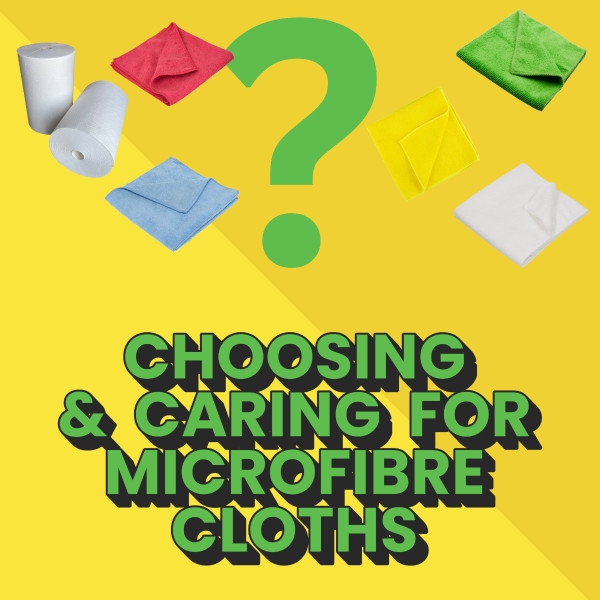Choosing and Caring for Microfibre Cloths
Whether you're in professional restoration, healthcare, or general cleaning, microfibre cloths have earned their place as an industry staple. But not all microfibres are created equal. Choosing the right cloth — and knowing how to care for it — can mean the difference between effective cleaning and wasted effort.
From fire and mould jobs to delicate polishing, this guide unpacks everything you need to know about microfibre cloths and how to maximise their value in your business.
What Is A Microfibre Cloth?
Microfibre is a synthetic fibre finer than a single strand of silk — about 1/5 the diameter of human hair. Microfiber cleaning cloths are usually made from polyester, nylon, or a mix of both. They are known for being very absorbent, soft, and great at cleaning tiny particles.
How Microfibre Is Made:
- Extrusion: Polyester and polyamide are melted and spun into ultra-thin threads.
- Splitting: Fibres are split during processing, creating more surface area.
- Weaving: Threads are woven or knitted into various cloth densities.
- Finishing: Cloths are treated and cut for specific uses.
How Microfiber Fabric Works
Unlike cotton or paper cloths, which push dirt around, microfibre lifts and traps particles. Thanks to the split fibres and increased surface area, microfibre:
- Attracts dirt and dust via static charge
- Absorbs oils and water with capillary action
- Cleans with or without cleaning products
- Removes bacteria and allergens down to 0.1 microns
GSM Explained: What It Means for You
GSM (Grams per Square Metre) indicates the weight and thickness of the cloth. Not the only factor in quality, but it gives a solid starting point for choosing the right tool for the job.
|
GSM |
Ideal For |
Key Benefits |
Considerations |
|---|---|---|---|
|
120 |
Disposable use, light-duty cleaning |
Cost-effective, fast drying |
Low absorbency, not durable |
|
180 |
General cleaning, kitchens, restrooms |
Good lifespan, soft and versatile |
LUp to 300 washes |
|
280 |
High-end cleaning, restoration work |
Plush, gentle, ultra-absorbent |
Up to 500 washes |
Restore Solutions’ Microfibre Range
We’ve curated a range of microfibre cloths to suit every cleaning challenge, whether you’re working in restoration, healthcare, or day-to-day maintenance.
ContainIT Microfibre Cleaning Cloth 180gsm (30x30cm Red)
- Midweight, great for general use
- Durable and versatile
- Reusable up to 300 washes
ContainIT Microfibre Cleaning Cloth 180gsm (40x40cm Green)
- Larger size for better coverage
- Suitable for regular washing and re-use
- Perfect for bathrooms, kitchens, and general surface cleaning
ContainIT Microfibre Cleaning Cloth 280gsm (40x40cm Blue)
- Premium-grade for professional cleaning
- Ideal for delicate or glossy surfaces
- Can withstand up to 500 washes — long-lasting investment
ContainIT Cleaning Cloth Roll 120gsm (32x41cm)
- Best for one-time use in fire, mould, or biohazard jobs
- Roll format for easy tear-off
- Economical for high-risk or disposable scenarios
Where Microfibre Shines in the Cleaning & Restoration Industry
Microfibre cloths aren’t just for dusting. Their unmatched versatility makes them essential across various sectors:
General Cleaning
- Streak-free finishes on glass, stainless steel, and bench tops
- Lint-free wiping in homes, offices, and commercial buildings
Healthcare & Infection Control
- Removes over 99% of bacteria with just water
- Reduces chemical use in sensitive environments
Fire & Water Damage Restoration
- Soft enough for fragile surfaces, effective on soot and ash
- High absorption for post-flood wipe-downs
Mould Remediation
- Helps physically remove mould spores post-treatment
- Gentle and non-abrasive on treated areas
Electronics & Precision Surfaces
- Cleans without scratching
- Ideal for screens, instruments, and lenses
When Not to Reuse Microfibre
While microfibre cloths are reusable, there are times when disposal is the safest or most efficient option:
- After cleaning fire and smoke damage
- Following Category 3 water loss
- If exposed to hazardous materials or bio-contaminants
- When visibly worn, degraded, or torn
- In environments without proper laundering facilities
How to Wash Microfibre Cloths
This is how to clean microfibre cloths to get the most use out of them:
- Wash separately from cotton or lint-producing fabrics
- Use cold or warm water with mild detergent
- Avoid bleach and fabric softeners – they degrade the fibres
- Air-dry or tumble dry low
Tip: Establish a colour-coded or tiered system — retire older cloths to lower-risk or drying tasks to maximise their lifespan.
Fit for Purpose: Smarter Systems, Better Results
Microfibre cloths are only as effective as the systems behind them. Create processes that align cloth type, GSM, and colour with task risk and intensity.
By matching the right microfibre to the right job — and knowing when to reuse or replace — you:
- Reduce waste
- Improve cleaning outcomes
- Lower long-term costs
- Maintain safety and hygiene standards
The Bottom Line
Microfibre cloths offer a high-performance, cost-effective, and eco-friendly solution for cleaning and restoration professionals. Whether you're tackling post-fire soot, prepping for a final polish, or wiping down a hospital room, there’s a microfibre option that fits the task — and your business model. By understanding GSM, proper care, and fit-for-purpose use, you’ll get the most from every cloth in your toolkit.
Recent Posts
-
Ten Years of Restore Solutions: Innovation for Restorers
In 2015, Restore Solutions entered the market with one clear purpose — to help restoration professio …2nd Dec 2025 -
The Ultimate Battery Operated Power Scrubber for Restoration Professionals
Less Elbow Grease, More Results: Meet the Battery-Powered Scrubber That Does the Hard Work for You S …17th Nov 2025 -
Choosing the Right Cleaning Chemicals in Restoration: Work Smarter, Work Safer
Chemical safety isn’t an optional extra in restoration — it’s the foundation of professional, consis …9th Nov 2025




